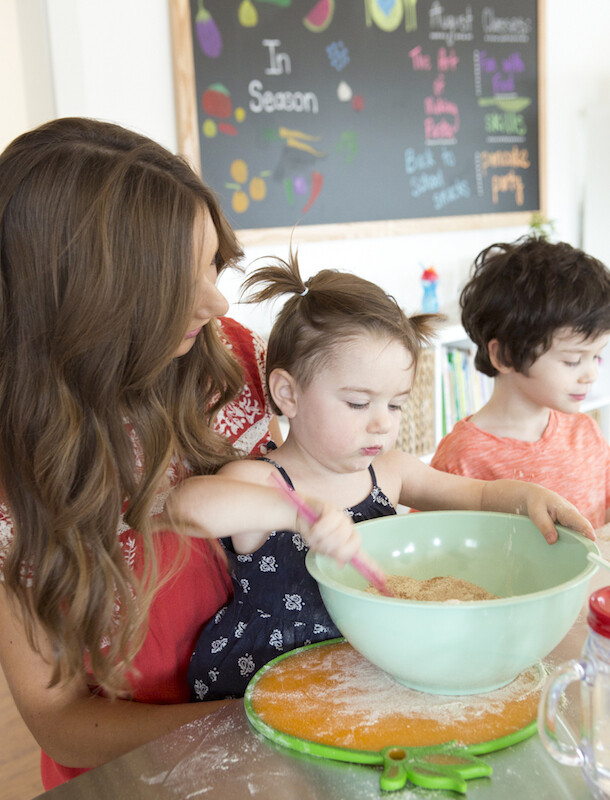When I was pregnant, I read the book Bringing Up Bébé about the benefits of the French parenting style. In one scene, the author recounts an experience where she watched one of her friends bake a cake with her 3-year-old daughter — a relaxing weekend tradition that is de rigueur in many French households. Ever since, I’ve carried around a fantasy of cooking with Phoebe, in which she calmly scoops out ingredients into a measuring cup, watched as I popped a perfect tray of cupcakes into the oven, then used it as a teaching opportunity on the virtues of patience (and the sweet rewards that it brings.) In reality, any cooking experiences Phoebe and I have shared in the first two years of her life have looked more like kitchen catastrophes, so my interest was piqued when I heard about a new kids’ cooking school called Patricia’s Table that just opened a couple miles from my house. Could it be the answer to my cooking-with-Phoebe fantasies? I headed over with my friend Jordan and her kids last week to find out.
*photos by Buff Strickland

When we arrived at the gorgeous light-filled kitchen, Patricia and her team had our ingredients and supplies neatly set out so the kids could get to work.

The owner, Patricia, is the gorgeous blond on the left, and I wanted to learn more about why she started Patricia’s Table, as well as her tips on having successful cooking experiences with kids at home. Her answers were so inspiring and made me want to get in the habit of involving Phoebe in the kitchen. She said:
Our goal is to equip and empower children to express themselves through the art, science, and joy of cooking. Cooking with your child creates the opportunity to teach kids where food comes from and to make a healthy connection with food. Over the years, I have seen that kids become more adventurous eaters when eating something they created. Additionally, cooking is a wonderful life skill and provides opportunities for kids to explore other cultures. Our hope is to honor kids’ intelligence during our classes and camps and encourage them in becoming confident, creative chefs.

CS: Is Phoebe – at 2 years old – too young to cook with me?
Patricia: Toddlers are great chefs! I started cooking with my niece at 18 months. It is a great age to explore food textures, colors, shapes and tastes. Toddlers learn to engage all the senses when cooking while learning life lessons like sharing and patience.
*Camille’s dress: asos; Phoebe’s dress: Gap (similar here.)

It’s important to create a healthy connection for your child to food early in life. In our Fun with Food series, toddlers are able to explore cooking with their parent. Kiddos learn kitchen safety and essential cooking skills like scooping and leveling to measure, chopping (with knife spatulas), rolling out dough, pinching, cutting out shapes and more.

Cooking is a fun and tasty way to strengthen fine motor skills. It can be as simple as adding a pinch of salt or placing a blueberry on a skewer. Some of our favorite recipes to make with kids this age are animal graham crackers, plant part salad, whole-wheat cheddar crackers and fruit skewers.

As kids get older, you can allow them to take over more steps in the recipe making process and incorporate more cooking tools. You can also incorporate cooking with eggs and meat, teach knife skills and let them experiment with their own recipes.

CS: Advice on picky eaters?
Patricia: Kids can be picky eaters for a number of reasons. Kids are more likely to eat what they create so our first recommendation is to help your child create something using that ingredient. We encourage the chefs at Patricia’s Table to taste their food by telling them that real chefs taste dishes to learn what they like or don’t like or what they might change. They also have to know if the food is seasoned well enough to send out of the kitchen.

Try incorporating new foods in different ways such as cold instead of hot or in a puree instead of pieces. Introduce one new food at a time. And it doesn’t hurt to sign them up for a cooking class! Cooking and eating in an environment with other kids can be helpful.

What are some of your favorite things to cook with kids?
Some of our favorite things to cook with kids are handmade pastas and sauces, seasonal pies and empanadas and cinnamon rolls. Of course, we could go on and on. There are so many different types of cuisine that we enjoy cooking with kids.

We have had a blast this summer with our cooking challenges in the older kids’ camps. They always amaze us with their creativity and we are so impressed to see them remember how to whip up a batch of fresh pasta or make a frittata with seasonal veggies using their knife skills.

Now for the recipe to the delicious homemade “animal cracker” cookies we made in class, and that Phoebe and I couldn’t stop eating…

Homemade “Animal Cracker” Cookies
Ingredients:
- 2 1/2 cups whole wheat flour*
- 1/2 cup light brown sugar
- 1 teaspoon baking soda
- 1 teaspoon cinnamon
- 1/2 cup unsalted butter, chilled
- 1/4 cup local honey
- 1/4 cup water, ice cold
*We love Richardson Farm’s whole wheat flour. You can order online and/or pick it up at the farmer’s market in Austin. We recommend using local or organic ingredients, if possible.

Instructions (cont. from previous slide)
- Preheat oven to 350 degrees F.
- In a food processor fitted with a steel blade, combine the first 5 ingredients.
- Cube chilled butter. Add butter cubes in the food processor and pulse until it resembles coarse meal.
- Add honey to the mixture and pulse.
- Slowly add cold water to the mixture and pulse until the dough comes together.
- Divide dough in half. Lightly dust the counter with whole wheat flour. Pat the dough or use a floured rolling pin to flatten the dough to about 1/4 inch thick.
- Using cookie cutters, cut out crackers. We love to use small animal-shaped cookie cutters. If you are making s’mores, you can cut the dough into squares.
- Place crackers on a parchment lined sheet pan. Repeat with the second batch of dough.
- Bake for 14-16 minutes or until slightly browned on the edges.

And George pops them into the oven! While the kids waited for their cookies to bake, we all headed out into the beautiful vegetable and herb garden outside Patricia’s Table.

CS: Tell us about the vegetable garden next to your kitchen?
Patricia: The garden is an essential part of Patricia’s Table. When looking for a space, I had envisioned an old house with a back yard garden. I still can’t believe that’s what we stumbled upon, but I feel very blessed to have found the perfect space. Kids learn best when you can immerse them in the environment they are studying. Our garden allows kids to see and learn about a plant’s lifecycle, explore the various parts of the plant and to pick vegetables and herbs they can cook with in the kitchen. Kids also water the plants and learn that having a garden is work and responsibility. I want kids to be good food stewards and our backyard garden provides that for our kid chefs.

CS: Tips for parents who might want to plant an herb or vegetable garden with their kids?
Patricia: Planting an herb garden is a great way to start gardening with your kids. You can plant seeds in a paper egg carton or out in your yard. Planting herbs from seeds allows them to watch the plant life cycle. Plant herbs kids can garnish their food with such as basil, parsley or chives.

We headed back inside to check on our cookies. The kids were so excited to see the final outcome of all their hard work, and were really proud that they’d made something so delicious using their own hands.

As all the other kids packed up their to-go bags of extra cookies, my hungry Phoebe dove in and devoured every last one. What can I say, she’s a growing girl!

If you live in Austin, be sure to check out the fun cooking sessions that are on the schedule at Patricia’s Table in the fall. Classes feature seasonal recipes using ingredients from local farms and their own backyard garden. Little chefs create each recipe from scratch, and each week will build on knowledge from the previous week.
I’d love to hear: do you guys cook with your kids at home? Any great tips?

To see more of Buff’s work, click here.







